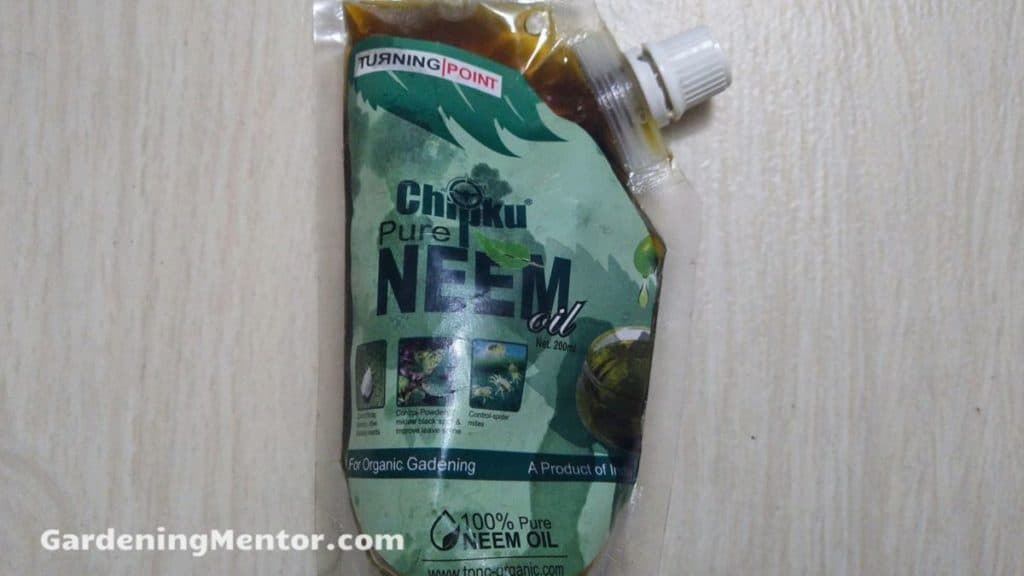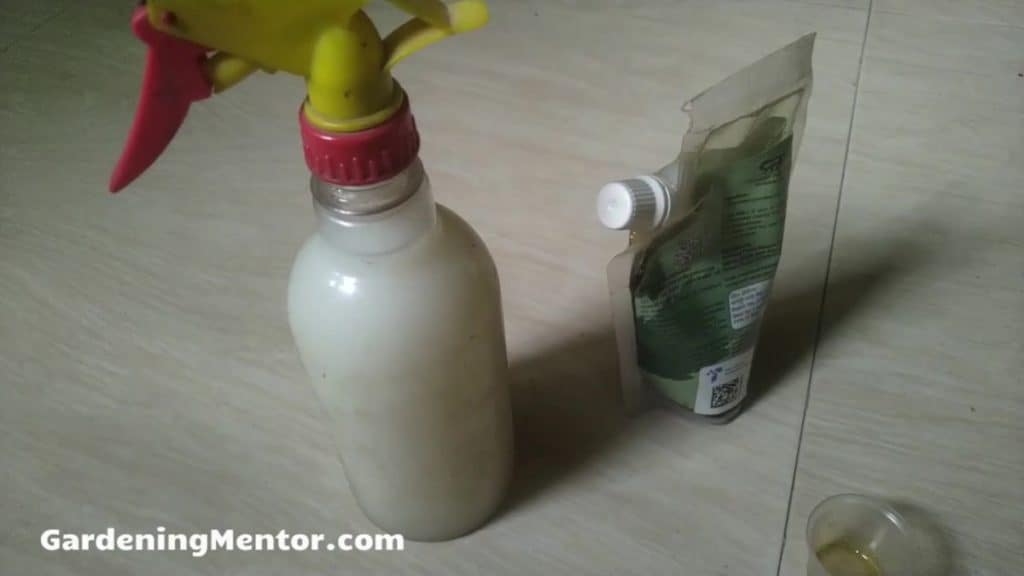It’s great to keep pests away.
Neem oil is an excellent organic solution to protect your plants from certain pests and diseases.
But too much of it can be a bad thing.
Neem oil can be harmful if your child or pet ingests too much in concentrated form. It can also burn the plant leaves.
Wash off neem oil from plants by spraying a soapy water solution made with 2 tablespoons liquid soap in a gallon of water. They wash off the soapy water with a spray of clean water using a sprayer, hose, or watering can. Soap will loosen the neem oil while water will remove it from the plant.
In this post, I’ll help you remove neem oil from your plant leaves. I’ll also explain why you should remove excess neem oil and how it benefits the plant.
Let’s begin.
How to get neem oil off plants
There are three simple steps you can follow to get neem oil off the plant.
1. Create a soap solution to spray on the plant
To get neem oil off of plants, the first step is to create a soap solution that will loosen the neem oil on the foliage.
Making this soap solution is relatively easy, and it does not take too many ingredients. All you need is water, liquid dish soap, and vegetable oil.
Mix one tablespoon of the liquid dish soap and one tablespoon of vegetable oil with a quart of water. Make sure to mix it well, so an emulsion is formed.

2. Spray the soap solution on the leaves
The second step for getting neem oil off your plants is spraying the plants with the soap solution explained above.
Add the solution to a spray bottle and make sure to shake it well before use. Spray it on all the leaves and stems of the plant. Make sure to spray on the underside of the leaves as well.
The best time to spray the solution is early morning before the sun comes out. This will protect the leaves from getting burned.

3. Clean the soap solution from the leaves
The third step for washing off neem oil is getting the soapy mixture off your plants. You can use a watering can or hose to water the leaves.
Once the soapy solution has remained on the leaves for a couple of minutes, you can wash it off. Spray water on the leaves, so the solution washes away.
Make sure to pour water on all the leaves and ensure you wash the underside of the leaves as well.
Neem oil can cause plant damage pretty easily.. It can suffocate a plant’s leaves because it forms a strong coat on their surface, and the thicker the neem oil, the harder it is for the leaves to get oxygen. Consuming neem oil is not healthy and can cause all kinds of negative side effects, especially in children – anything from headaches to brain disorders. It can also trigger miscarriages so pregnant women need to be extra cautious. – Jeremy Yamaguchi, CEO, Lawn Love
Why should I wash neem oil off plants?
You should wash neem oil off plants because it can be toxic to children or pets if they ingest too concentrated neem oil. The neem oil can also burn the leaves of the plant when concentrated.
There is a lot of fuss over whether or not neem oil should be washed off of a plant. After all, it is considered non-toxic as long as it is used with caution.
If accidentally ingested, concentrated neem oil can be toxic. This can cause issues, especially if you have pets. Dogs or other outdoor animals might be curious about the unusual smell and attempt to eat the oil. This can cause nausea, vomiting, diarrhea, or other severe issues for the animal.
Pets can be gravely harmed from the impact of eating neem oil, particularly if they eat large amounts. Although the overall results of pets eating neem oil are largely unknown, the potential of an animal ingesting it should be avoided at all costs.
In addition to animals, humans can face lethal results if they happen to ingest concentrated neem oil. Those who are most often impacted are young children. This is because they are smaller and therefore more susceptible to its damages. In addition, children may not be aware of the outcomes of eating neem oil, so they may consume it without a second thought.
The effects of consuming neem oil are apparent within hours for children. The lesser side effects include drowsiness, lethargy, and nausea. However, the effects can quickly take a dark turn and lead to seizures or even death. In addition to children, neem oil can harm pregnant women as well. Neem oil can harm the fetus and cause miscarriages.
As you can see, neem oil can be damaging for pets, children and infants, and pregnant women who consume it. Most of the time, the side effects are a mere inconvenience and are not a significant cause for concern. However, the effects of neem oil can also be fatal, and it is not worth the risk. Because of these effects, it is recommended to wash neem oil off your plants.
Can neem oil cause damage to the plant?
Neem oil can cause damage to the plant when it’s used excessively or in its concentrated form. The oil will coat the leaves and burn them.
Neem oil is a natural pesticide and fungicide. It is meant to prevent the plant from getting attacked by insects that may cause harm. In addition, neem oil can be used to stop the spread of different occurring fungi.
The oil needs to be on every part of the leaf, even if this seems as though this much neem oil is needlessly extreme. Because of this, many over calculate how much neem oil they need.
They take the advice of completely covering the leaves with it, and they begin submerging the plant. Such practices can cause significant harm to the plant, and in some cases, it may cause the plant to die.
If too much neem oil is used, the neem oil will smother the leaves and cause them to burn. Leaves that have too much neem oil on them will not be able to breathe and, therefore, will result in irrevocable damage.
Coating the leaves in too much neem oil can be extremely harmful. Follow the directions on your neem oil bottle so you can avoid harming your plant.
Do not worry, however, as many plants can recover from burned leaves. It should fair well after recovery as long as the plant is not continually placed in harmful situations.

Fact Checked, Written, and Published by Kevin Rodrigues
Kevin is the founder of Gardening Mentor, a website that aims to teach people to grow their own food in a limited space. As a self-taught gardener, Kevin has spent several years growing plants and creating gardening content on the website. He is certified in Home Horticulture and Organic Gardening from Oregon State University. He has a Post Graduate Diploma in Horticulture and Landscape Gardening from Mumbai University.
Read more
